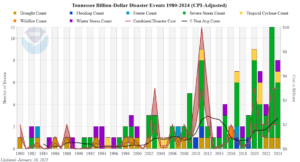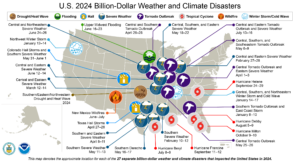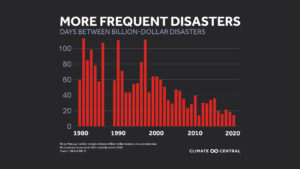
The National Oceanic and Atmospheric Administration announced last week that it will no longer track the nation’s costliest storms.
For more than four decades, NOAA has provided a public tool to examine the cost of weather and climate events: a database of “billion-dollar disasters,” which are disasters that cost at least $1 billion in damages.
Between 1980 and 2024, Tennessee residents endured at least part of 116 separate billion-dollar disasters. Most massive storm events affect multiple states at once — so not every event costs a billion dollars in a given state. In Tennessee, the 116 storms caused damages amounting to an estimated $20-$50 billion.
 Courtesy National Oceanic and Atmospheric Administration
Courtesy National Oceanic and Atmospheric Administration Tennessee set a record for billion-dollar disasters in 2023, with a total of 11 disasters.
NOAA deleted its preliminary 2025 data on four potential billion-dollar disasters: including the wildfires in Los Angeles in January, severe weather in the South in March, the tornado and severe weather in the Southeast in March, and the South and Midwest flooding and tornadoes in April. Tennessee was impacted by the latter two events, including the recent extreme rainfall in April.
Climate change and development patterns have made storms costlier in Tennessee
Tennessee experienced more billion-dollar disasters in the past five years than any other decade since the federal government began documenting them. Between 2020 and 2024, 39 disasters hit the state with an accumulated cost of $10 to $20 billion.
Some extreme weather events are becoming more common because fossil fuel burning, primarily, has raised temperatures on Earth.
The issue has been compounded by development, which some research suggests could be the dominant factor in raising the economic cost of storms in recent years. Much of the population growth and development in the U.S. has occurred in vulnerable areas, like coasts, wildland-urban interfaces and river floodplains, according to NOAA. In Tennessee, this issue could worsen in the coming years as the state recently passed a law to remove regulations for wetlands, the flood-holding land near waterways.
Last year, the state faced 9 separate billion-dollar disasters, including five severe storms, one winter storm, one tropical cyclone and one drought. Tennessee set a new record in 2023 with 11 disasters — 10 severe storms and one drought.
 Courtesy National Oceanic and Atmospheric Administration
Courtesy National Oceanic and Atmospheric Administration Tennessee was impacted by 9 billion-dollar disasters in 2024.
Severe storms, which NOAA defines as tornadoes, hail and heavy winds, accounted for more than half of the state’s costliest disasters since 1980. Drought and winter storms accounted for the next largest chunk, followed by tropical cyclones.
“Flooding” only accounted for four of these disasters, all occurring in the 2010-2019 decade. But flooding was a big part of some of the other disasters. Last September, East Tennessee was impacted by back-to-back storms, one being Hurricane Helene, a type of tropical cyclone. This storm system caused nearly $80 billion in damages and 219 deaths across multiple states in the Southeast. North Carolina had the most impacts stemming from extreme rainfall, with one county station recording more than 30 inches in three days. A lot of that rainfall flowed into Tennessee, threatening high-hazard dams and causing significant property damage.
Some major rainfall events in Tennessee were highly “localized” — meaning the rain only occurs in a small area — and did not cause enough damage to be considered a billion-dollar disaster. The most notable example is the August 2021 flooding in Middle Tennessee: more than 20 inches of rainfall fell in McEwen within 24 hours and drained into Waverly, killing 20 people and destoying homes, roads and businesses. That event set a new record for a daily rainfall in a non-coastal U.S. state, but the damages only totaled about $90-100 million due to the narrow range of the storm.
 Caroline Eggers WPLN News
Caroline Eggers WPLN NewsTwo cars swept away by floodwaters collided with a house during the deadly storm in Waverly, Tennessee on August 21, 2021.
Widespread drought affected Tennessee the past three years in a row, causing agricultural losses. The state was also struck by two major winter storms during the past two winter seasons, with the first leading to a rolling blackout caused by failed fossil fuel generation.
Extreme weather events are becoming more frequent
Disaster frequency fluctuates year to year, but the long-term trend is more extreme weather events. Nationally, the average time between billion-dollar disasters dropped from 82 days in the 1980s to 18 days between 2016 and 2020, according to an analysis from Climate Central.
More: Nashville area sees 161 tornado, thunderstorm and flash flood warnings in two weeks | WPLN News
 Courtesy Climate Central
Courtesy Climate Central Costly weather disasters are happening more frequently as the climate warms in the U.S.
Historically, the South, Central and Southeast regions have experienced the most billion-dollar disasters and are projected to continue having the most impacts across several socioeconomic metrics, according to NOAA.

